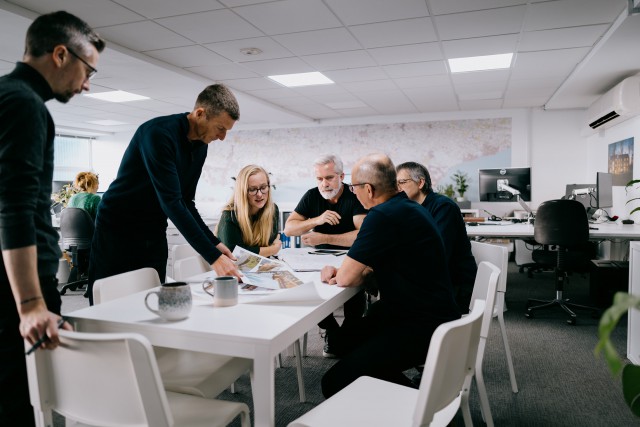Sustainability
Working together to reduce CO₂
Sustainability has become a primary component in the way we approach design. We’re committed to working with our clients to help minimise the negative environmental impact of buildings in all our design projects and working practices.
For us, sustainable design opens up new opportunities to improve quality, resilience and efficiency by respecting the setting, users, neighbouring communities and ecosystem – saving money and emissions in the long term.
In all our projects, we aim to follow our Eight Key Sustainability Principles outlined below, each of which is intertwined and led by our commitment toUK Architects Declare and RIBA Climate Challenge 2030.
We believe that as architects we have a responsibility as well as the agency to design for the health of both people and the planet.
We’re proud to champion sustainability at Miller Bourne in our design and working practices.
We believe a more sustainable future starts with us. That’s why we’ve put in place a carbon reduction plan that will see Miller Bourne become Carbon Neutral by 2030.
Nearly 40% of global CO₂ emissions are associated with the construction sector, along with a decline in biodiversity. The time for action is now. Our goal is to put sustainability at the heart of every project.

Miller Bourne Eight Key Sustainability Principles
The way we live is evolving. At Miller Bourne, we’re working to shape environments that support this in all the following ways:
Operational emissions are the greenhouse gas emissions arising during the use of a building. They are directly related to its energy efficiency and what kind of energy the building uses for ‘regulated’ uses like heating, cooling, ventilation, lighting and hot water, as well as ‘unregulated’ uses such as equipment, appliances and anything that is plugged in by the users of the building and uses electricity. Although in building design, our main impact is on ‘regulated’ energy, to achieve true Net Zero emissions we have to consider both. We therefore work closely with the building services engineers to understand and reduce the operational emissions according to this hierarchy:
- Passive Measures: Passive measures, such as efficient building form and massing, appropriate orientation for balancing solar gain, overheating, sufficient daylight and passive ventilation, glazing ratios and shading are the starting point of an energy efficient building. Getting this first step right will reduce the demand on the building fabric and services later on.
- Efficient Fabric: Once the building form is understood, the next step is to ensure a highly insulated and airtight building fabric free of thermal bridges.
- Low energy systems: Fossil fuel-based sources such as gas boilers are to be avoided. Consider heat pumps for space heating and hot water, as well as mechanical ventilation with heat recovery to keep down energy demand while improving air quality.
- Renewable energy: Once building fabric and services have been optimised, incorporate renewable energy, such as solar panels to meet the reduced energy demand.
The carbon from producing the building materials, construction processes and material waste can represent upwards of two-thirds of the total carbon emissions of a project over its lifetime.
Embodied carbon needs to be considered right at the outset of a project and concerns everything from placement on site the type of structure, construction materials and interior finishes.
The reuse of buildings, structures and construction materials where possible, designing our buildings to be long lasting, reducing the amount of materials required and prioritising natural, regenerative, bio-based materials over high carbon options are all priorities for us.
To reduce our carbon emissions, the most effective thing we can do is to reuse and retrofit our existing buildings.
80% of the buildings that will be standing in 2030 in the UK already exist today. A holistic retrofit that considers the relationships between building fabric, airtightness, ventilation, heating source and building services is therefore the most effective step to take towards reducing the carbon impact of a building.
Our considerations for a sustainable water cycle for our buildings have two aspects: potable water saving strategies to reduce the amount used and therefore the strain on water resources and sustainable drainage strategies to reduce flooding which usually forms part of planning requirements and goes hand in hand with landscape design and biodiversity.
A sustainable building should provide a healthy and comfortable environment for its occupants. This means good thermal comfort, good air quality, healthy materials, plenty of daylight, acoustic comfort, links to nature, ease of use, and accessibility for all.
By designing to circular economy principles, we strive to eliminate waste by designing for restoration, regeneration and reuse. This means conserving resources by avoiding demolition, adapting existing buildings and reusing structures and materials, as well as designing to eliminate future waste by specifying for longevity, adaptability, reusability and ease of maintenance.
Along with climate change, our built environment is closely linked to ecosystem, biodiversity and habitat loss, with consequences from every project.
The need for an ecology-based approach has been recognised by the Environment Act 2021. From Autumn 2023, it will become mandatory to achieve Biodiversity Net Gain of a minimum of 10% on all development sites, requiring that all sites are delivered in better ecological condition than they were prior to the works.
Designing for nature – rather than against it – not only helps us on the way to biodiversity regeneration but also improves human health and wellbeing.
The future health, wellbeing, and prosperity of people is intrinsically linked to the quality of the places and environment they inhabit. We see a key aspect of sustainable design as its ability to provide an opportunity for existing and new communities to thrive and participate in a healthy, welcoming, connected and inclusive environment.
